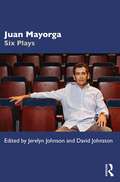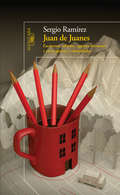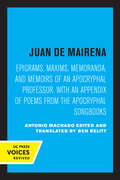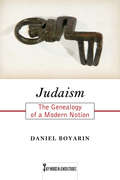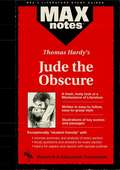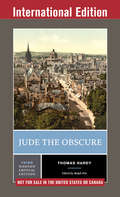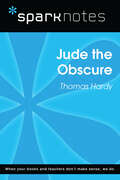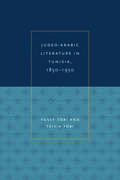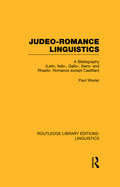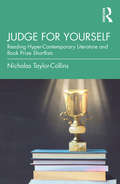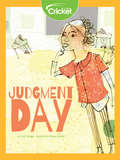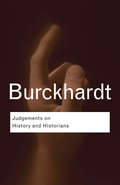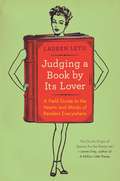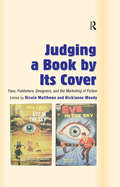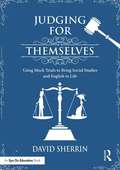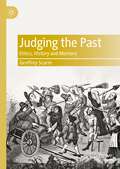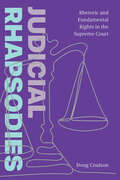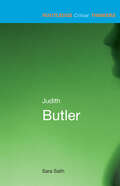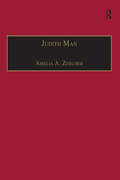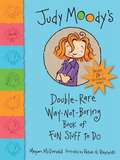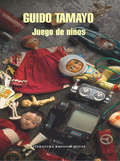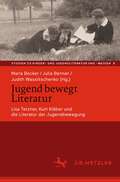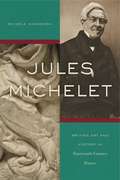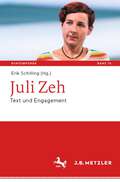- Table View
- List View
Juan Mayorga: Six Plays
by David Johnston Jerelyn JohnsonJuan Mayorga: Six Plays is the first collection of Spanish dramatist Juan Mayorga’s plays in English, offering a compelling insight into the extraordinary range and quality of one of the Spanish-speaking world’s most distinctive voices.The six plays are presented in translations that are both readable and eminently performable. Each is accompanied by a translator’s note that discusses the strategies and decisions used in making the play performable in English as well as the play’s key themes. The book also features an introduction to Mayorga’s life and work, emphasising his commitment to plays whose range of forms and innovative theatre-making practice re-imagines the nature of theatre and performance each time anew. The plays themselves are brilliant treatises on our times, inspiring conversation about and critical examination of our troubled world.These scripts will be of interest to professional practitioners but are no less suited to both university and amateur settings, making this the definitive collection of Mayorga’s work in English for theatremakers, students, and scholars.
Juan de Juanes
by Sergio Ramírez«Para ser un escritor se necesita creer sin vacilaciones en los tesoros escondidos en el fondo de las lagunas y ser sobrino de unos tíos mentirosos; al fin y al cabo, contar no es más que aprender a mentir con aplomo. Mentir, mentir, que de la mentira algo queda.»Esta obra emprende una defensa apasionada de la escritura, la literatura, la memoria y la amistad. Es un compendio de recuerdos, lecturas, anécdotas, hechos memorables... La memoria es también una suerte de homenaje a los amigos que nos han acompañado a lo largo de la vida, aquellos con quienes compartimos la mesa, los libros, los viajes y, en el caso de Sergio Ramírez, la revolución. En el amplio mapa de recuerdos de Juan de Juanes, Sergio Ramírez va trazando la ruta que nos lleva desde sus inicios como escritor, el triunfo de la revolución sandinista en su natal Nicaragua, el premio Alfaguara en 1998, hasta la entrega del Premio Iberoamericano de Letras José Donoso 2011, pocos días antes del suicidio de la única heredera del escritor chileno, Pilar Donoso. En las páginas de Juan de Juanes Sergio Ramírez nos cuenta acerca de personajes memorables en su vida, con quienes quedó en deuda, entre otros Carlos Fuentes, Julio Cortázar, Augusto Monterroso, Gabriel García Márquez, Jorge Luis Borges, Ernesto Cardenal y Juan Cruz, su primer editor y punto de partida de este viaje por Latinoamérica. El autor revive en Juan de Juanes años de vida y de literatura, en los que escritores, editores, agentes literarios y por supuesto nosotros, sus lectores, descubrimos el Juan de Juanes total que llevamos dentro.
Juan de Mairena: Epigrams, Maxims, Memoranda, and Memoirs of an Apocryphal Professor. With an Appendix of Poems from the Apocryphal Songbooks
by Antonio MachadoThis title is part of UC Press's Voices Revived program, which commemorates University of California Press’s mission to seek out and cultivate the brightest minds and give them voice, reach, and impact. Drawing on a backlist dating to 1893, Voices Revived makes high-quality, peer-reviewed scholarship accessible once again using print-on-demand technology. This title was originally published in 1963.
Judaism: The Genealogy of a Modern Notion (Key Words in Jewish Studies #35)
by Daniel BoyarinJudaism makes the bold argument that the very concept of a religion of ‘Judaism’ is an invention of the Christian church. The intellectual journey of world-renowned Talmud scholar Daniel Boyarin, this book will change the study of “Judaism”—an essential key word in Jewish Studies—as we understand it today. Boyarin argues that although the world treats the word “Judaism” as appropriate for naming an alleged religion of the Jews, it is in fact a Christian theological concept only adopted by Jews with the coming of modernity and the adoption of Christian languages.
Jude the Obscure (MAXNotes Literature Guides)
by Lauren KalmansonREA's MAXnotes for Thomas Hardy's Jude the Obscure MAXnotes offer a fresh look at masterpieces of literature, presented in a lively and interesting fashion. Written by literary experts who currently teach the subject, MAXnotes will enhance your understanding and enjoyment of the work. MAXnotes are designed to stimulate independent thought about the literary work by raising various issues and thought-provoking ideas and questions. MAXnotes cover the essentials of what one should know about each work, including an overall summary, character lists, an explanation and discussion of the plot, the work's historical context, illustrations to convey the mood of the work, and a biography of the author. Each chapter is individually summarized and analyzed, and has study questions and answers.
Jude the Obscure (Norton Critical Editions #0)
by Thomas Hardy Ralph PiteThis Third Norton Critical Edition of Hardy’s final novel has been revised to reflect the breadth of responses it has received over the last fifteen years. The text of the novel is again based on Hardy’s final revision for the 1912 Wessex Edition. The Norton Critical Edition also includes: · Expanded footnotes by Ralph Pite, further drawing out Hardy’s web of allusions and comprehensively indicating the material culture in which he embeds this narrative. · A selection of Hardy’s poems—four of them new to the Third Edition—that emphasizes the biographical contexts from which parts of Jude the Obscure arose. · Eighteen critical responses, including eleven modern essays—eight of them new to the Third Edition. Simon Gatrell, Michael Hollington, Elaine Showalter, Victor Luftig, and Mary Jacobus are among the new voices. · A Chronology and revised and expanded Selected Bibliography.
Jude the Obscure (SparkNotes Literature Guide Series)
by SparkNotesJude the Obscure (SparkNotes Literature Guide) by Thomas Hardy Making the reading experience fun! Created by Harvard students for students everywhere, SparkNotes is a new breed of study guide: smarter, better, faster. Geared to what today's students need to know, SparkNotes provides: *Chapter-by-chapter analysis *Explanations of key themes, motifs, and symbols *A review quiz and essay topicsLively and accessible, these guides are perfect for late-night studying and writing papers
Judeo-Arabic Literature in Tunisia, 1850-1950
by Tsivia Tobi Yosef TobiAs a result of the introduction of the printing press in the mid-nineteenth century and the proximity of European culture, language, and literature after the French occupation in 1881, Judeo-Arabic literature flourished in Tunisia until the middle of the twentieth century. As the most spoken language in the country, vernacular Judeo-Arabic allowed ideas from the Jewish Enlightenment in Europe (the Haskalah) to spread widely and also offered legitimacy to the surrounding Arab culture. In this volume, authors Yosef and Tsivia Tobi present works of Judeo-Arabic Tunisian literature that have been previously unstudied and unavailable in translation. In nine chapters, the authors present a number of works that were both originals and translations, divided by genre. Beginning each with a brief introduction to the material, they present translations of piyyutim (liturgical poems), malzumat (satirical ballads), qinot (laments), ghnayat (songs), essays on ideology and propaganda, drama and the theater, hikayat and deeds of righteous men (fiction), and Daniel Hagège's Circulation of Tunisian Judeo-Arabic Books, an important early critical work. A comprehensive introduction details the flowering of Judeo-Arabic literature in North Africa and appendixes of Judeo-Arabic journals, other periodicals, and books complete this volume. Ultimately, the authors reveal the effect of Judeo-Arabic literature on the spiritual formation of not only the literate male population of Tunisian Jews, who spent a good part of their time at the synagogue, but also on women, the lower and middle classes, and conservatives who leaned toward modernization. Originally published in Hebrew, Judeo-Arabic Literature in Tunisia, 1850-1950 will be welcomed by English-speaking scholars interested in the literature and culture of this period.
Judeo-Romance Linguistics: A Bibliography (Latin, Italo-, Gallo-, Ibero-, and Rhaeto-Romance except Castilian) (Routledge Library Editions: Linguistics #Vol. 890)
by Paul WexlerA separate bibliographic treatment of the Judeo-Romance languages should facilitate a deeper appreciation of the contributions that they may make to Romance linguistics in general. Up until now, Judeo-Romance topics have scarcely been canvassed in Romance linguistic bibliographies. It is hoped that this new book serves to popularize the field of Judeo-Romance languages both among students of general Romance and comparative Jewish linguistics.
Judge for Yourself: Reading Hyper-Contemporary Literature and Book Prize Shortlists
by Nicholas Taylor-CollinsJudge for Yourself guides interested and advanced-level readers through the challenge of judging the quality of hyper-contemporary literature. Whether reading the latest bestseller or the book that everyone is recommending, Judge for Yourself guides you through the challenge of the text. Reading the longlist of the 2019 International Dylan Thomas Prize through five chapters, Judge for Yourself introduces readers to current critical debates that inform engagement and the reading experience of hyper-contemporary writing. Topics covered include feminism, postcolonialism, critical race theory, queer theory, class, and book reviews. Each chapter includes introductory questions for the reader, and Judge for Yourself is accompanied by an exploration of book prize culture and the challenge posed by hyper-contemporary literature. Judge for Yourself puts judging firmly in the hands of the reader, and not the academic or professional reviewers.
Judgement Day
by Carly SchunaOlivia has been studying every day for the spelling bee at her middle school. She is sure she can beat her arch-rival, Nathan. When the bee finally arrives, will Olivia be able to out-spell Nathan? Will she find out that she and Nathan have more in common than just being good spellers?
Judgements on History and Historians (Routledge Classics Ser.)
by Jacob BurckhardtWestern Civilisation was in its pomp when Jacob Burckhardt delivered his Judgements on History and Historians; European Empires spanned the globe, while the modern age was being forged in the nationalist revolutions of 1848. As a tutor to the young Friedrich Nietzsche as well as one of the first historians to take 'culture' as his subject rather than the triumphs and travails of kings and generals, Burckhardt was at the vanguard of this modern sensibility. Ambitious in its scope, ranging from the days of Ancient Egypt, through the Reformation to the time of Napoleon, this is indeed a history of 'Western Civilization', written before two monstrous world wars threw such a concept into disrepute.
Judging a Book By Its Lover
by Lauren LetoWant to impress the hot stranger at the bar who asks for your take on Infinite Jest? Dying to shut up the blowhard in front of you who's pontificating on Cormac McCarthy's "recurring road narratives"? Having difficulty keeping Francine Prose and Annie Proulx straight? For all those overwhelmed readers who need to get a firm grip on the relentless onslaught of must-read books to stay on top of the inevitable conversations that swirl around them, Lauren Leto's Judging a Book by Its Lover is manna from literary heaven! A hilarious send-up of--and inspired homage to--the passionate and peculiar world of book culture, this guide to literary debate leaves no reader or author unscathed, at once adoring and skewering everyone from Jonathan Franzen to Ayn Rand to Dostoyevsky and the people who read them.
Judging a Book by Its Cover: Fans, Publishers, Designers, and the Marketing of Fiction
by Nickianne MoodyHow do books attract their readers? This collection takes a closer look at book covers and their role in promoting sales and shaping readers' responses. Judging a Book by Its Cover brings together leading scholars, many with experience in the publishing industry, who examine the marketing of popular fiction across the twentieth century and beyond. Using case studies, and grounding their discussions historically and methodologically, the contributors address key themes in contemporary media, literary, publishing, and business studies related to globalisation, the correlation between text and image, identity politics, and reader reception. Topics include book covers and the internet bookstore; the links between books, the music industry, and film; literary prizes and the selling of books; subcultures and sales of young adult fiction; the cover as a signifier of literary value; and the marketing of ethnicity and lesbian pulp fiction. This exciting collection opens a new field of enquiry for scholars of book history, literature, media and communication studies, marketing, and cultural studies.
Judging for Themselves: Using Mock Trials to Bring Social Studies and English to Life
by David SherrinLearn how to use mock trials to bring history and literature to life! When students take on the roles of lawyers and witnesses in historical or literary trials, they develop greater investment in the topics, they learn rigorous close-reading and questioning techniques, and they are able to deeply explore and reflect upon themes of justice and responsibility. In this new book from award-winning teacher David Sherrin, you#65533;ll find out how this lively instructional strategy will make learning a more immersive, engaging, and memorable experience for your middle school and high school students. The book includes: a clear how-to guide to get the most out of mock trials in your class; ready-made units and lessons to get you started right away, complete with sample scripts, primary source documents, scaffolding worksheets, and assessment rubrics; templates and step-by-step instructions to help you design your own mock trials. The pre-made units, which Sherrin spent years refining in his classroom, cover historical topics such as the Nuremberg Trials and the inquisitions of Martin Luther and Galileo. You#65533;ll also find fun and interactive mock trials based on the literary works The Pearl and To Kill a Mockingbird. These lessons will help students at all ability levels to become better readers, public speakers, and critical thinkers. For even more engaging lessons, try out Sherrin#65533;s companion book on role-plays, The Classes They Remember: Using Role-Plays to Bring Social Studies and English to Life.
Judging the Past: Ethics, History and Memory
by Geoffrey ScarreThis book presents an extended argument for the thesis that people of the present day are not debarred in principle from passing moral judgement on people who lived in former days, notwithstanding the inevitable differences in social and cultural circumstances that separate us. Some philosophers argue that because we can see things only from our own peculiar historical situation, we lack a sufficiently objective vantage point from which to appraise past people and their acts. If they are correct, then the judgements passed by twenty-first-century people must inevitably be biased and irrelevant, grounded on moral standards that would have seemed alien in that 'foreign country' of the past. This book challenges this relativistic position, contending that it seriously underestimates our ability to engage imaginatively with people who, however much their lifestyles may have differed from our own, were our fellow human beings, endowed with the same basic instincts, aversions, desires and aspirations. Taking a stand on a naturalistic theory of human beings, coupled with a Kantian conception of the equal worth of all human members of the Kingdom of Ends, Scarre argues that historical moral judgements can be sensitive to circumstances, fitting and fair, and untainted by anachronism. The discussion ends by examining the implications of this position for the practice of historians and for the ethics of memory and commemoration.
Judicial Rhapsodies: Rhetoric and Fundamental Rights in the Supreme Court
by Doug CoulsonAll judges legitimize their decisions in writing, but US Supreme Court justices depend on public acceptance to a unique degree. Previous studies of judicial opinions have explored rhetorical strategies that produce legitimacy, but none have examined the laudatory, even operatic, forms of writing Supreme Court justices have used to justify fundamental rights decisions. Doug Coulson demonstrates that such “judicial rhapsodies” are not an aberration but a central feature of judicial discourse. First examining the classical origins of divisions between law and rhetoric, Coulson tracks what he calls an epideictic register—highly affective forms of expression that utilize hyperbole, amplification, and vocabularies of praise—through a surprising number of landmark Supreme Court opinions. Judicial Rhapsodies recovers and revalues these instances as significant to establishing and maintaining shared perspectives that form the basis for common experience and cooperation. “Judicial Rhapsodies is both compelling and important. Coulson brings his well-developed knowledge of rhetoric to bear on one of the most central (and most democratically fraught) means of governance in the United States: the Supreme Court opinion. He demonstrates that the epideictic, far from being a dispensable or detestable element of judicial rhetoric, is an essential feature of how the Court operates and seeks to persuade.” —Keith Bybee, Syracuse University
Judith Butler (Routledge Critical Thinkers)
by Sara SalihSince the publication of Gender Trouble in 1990, Judith Butler has revolutionised our understanding of identities and the ways in which they are constructed. This volume examines her critical thought through key texts, touching upon such issues as:* The subject* Gender* Sex* Language* The PsycheWith clear discussions of the context and impact of Butler's work and an extensive guide to further reading, this book offers an excellent introduction to one of the most influential critical thinkers writing today.
Judith Man: Printed Writings 1500–1640: Series I, Part Three, Volume 2 (The Early Modern Englishwoman: A Facsimile Library of Essential Works & Printed Writings, 1500-1640: Series I, Part Three #Pt. 3)
by Amelia A. ZurcherAn Epitome of the History of Faire Argenis and Polyarchus is Judith Man's English translation of a 1623 French work by Nicolas Coeffeteau, Histoire de Poliarque et d'Argenis, which is itself an abridgement and translation of one of the most widely read fictional works of the seventeenth century, John Barclay's 1621 Latin romance Argenis. An extended political allegory of the rise to power of the French king Henri IV, Barclay's romance is peppered with numerous veiled anecdotes of politics at the English and other European courts and long disquisitions on statecraft and political ethics. It has been assumed that Barclay's work was strictly for a male audience, but Man's translation is evidence that women did in fact read Argenis, and might even suggest that allegorical romance offered women writers and readers an inroad into political discourse.
Judy Moody's Double-Rare Way-Not-Boring Book of Fun Stuff to Do
by Megan Mcdonald"Designed to scare away the boredom blahs." -- Publishers Weekly. Ready to join the T. P. (Take out your Pencil) Club? Get the low-down on Screamin' Mimi's ice cream; knock yourself out learning knock-knock jokes; try out your Judy Moody trivia with quizzes and crosswords; plan a Judy-themed birthday party; make your own Me collage, cootie catcher, or custom T-shirt; and much, MUCH more. Whether the reader has just met Judy or is already her biggest fan, this fun-filled activity book -- complete with twenty-four stickers -- absolutely and positively rates a "rare squared."
Juego de niños
by Guido TamayoLa segunda novela de Guido Tamayo. Una novela de Guido Tamayo que nos habla sobre tres niños, su amistad y la llegada a la adultez. La crítica ha dicho: "Una bella novela sobre la infancia. Sobre lo que ya se ha ido y sólo se recupera a través de la palabra. Y la de Guido Tamayo es sencilla, honda y poética. Sus personajes conmueven en su desolada iniciación al amor y a la muerte. En estas páginas el dolor y la ternura se abrazan inolvidablemente". Pablo Montoya "Juego de niños, de Guido Tamayo, recupera con intensidad la edad de la definición, el momento inmodificable en que alguien sella su destino. Una obra singular sobre el rito de paso en que la infancia se extingue para convertirse en el incendio que definirá la vida adulta. Con cambiantes perspectivas, retrata al grupo disfuncional por excelencia: la familia". Juan Villoro
Jugend bewegt Literatur: Lisa Tetzner, Kurt Kläber und die Literatur der Jugendbewegung (Studien zu Kinder- und Jugendliteratur und -medien #8)
by Maria Becker Julia Benner Judith WassiltschenkoDas Autorenpaar Lisa Tetzner (1894-1963) und Kurt Kläber (1897-1959, Pseudonym Kurt Held) kann in der Geschichte der deutschsprachigen Kinder- und Jugendliteratur nicht überschätzt werden. Die im Exil entstandenen Klassiker Die Kinder aus der Nummer 67, Die schwarzen Brüder und Die rote Zora und ihre Bande sind dem Publikum bis heute bekannt. Der Beginn ihrer produktiven Partnerschaft liegt bereits in der Jugendbewegung. Tetzner und Kläber begegneten sich auf Zusammenkünften von organisierten Jugendgruppen und pflegten Kontakt zu zahlreichen Persönlichkeiten aus diesem Umfeld, u. a. Eugen Diederichs, Friedrich Muck-Lamberty und Gertrud Prellwitz. Einige Beiträge des interdisziplinär angelegten Sammelbands zeigen detailliert, wie die frühe Auseinandersetzung mit den Ideen der Jugendbewegung das Werk des Autorenpaars nachhaltig prägte. Andere Aufsätze befassen sich mit der literarischen Darstellung der Jugendbewegung und literarischen Phänomenen aus dem Kontext der Jugendbewegungen in zeitgenössischen Werken weiterer Autor*innen, darunter Friedrich Wolf und Else Ury. Damit wird der Forschung erstmals ein tieferes Verständnis vom Konnex Jugendbewegung – Jugendlichkeit – Jugendliteratur geboten.
Jules Michelet: Writing Art and History in Nineteenth-Century France
by Michèle HannooshJules Michelet, one of France’s most influential historians and a founder of modern historical practice, was a passionate viewer and relentless interpreter of the visual arts. In this book, Michèle Hannoosh examines the crucial role that art writing played in Michelet’s work and shows how it decisively influenced his theory of history and his view of the practice of the historian.The visual arts were at the very center of Michelet’s conception of historiography. He filled his private notes, public lectures, and printed books with discussions of artworks, which, for him, embodied the character of particular historical moments. Michelet believed that painting, sculpture, architecture, and engraving bore witness to histories that frequently went untold; that they expressed key ideas standing behind events; and that they articulated concepts that would come to fruition only later.This groundbreaking reevaluation of Michelet’s approach to history elucidates how writing about art provided a model for the historian’s relation to, and interpretation of, the past, and thus for a new type of historiography—one that acknowledges and enacts the historian’s own implication in the history he or she tells.
Jules Michelet: Writing Art and History in Nineteenth-Century France
by Michèle HannooshJules Michelet, one of France’s most influential historians and a founder of modern historical practice, was a passionate viewer and relentless interpreter of the visual arts. In this book, Michèle Hannoosh examines the crucial role that art writing played in Michelet’s work and shows how it decisively influenced his theory of history and his view of the practice of the historian.The visual arts were at the very center of Michelet’s conception of historiography. He filled his private notes, public lectures, and printed books with discussions of artworks, which, for him, embodied the character of particular historical moments. Michelet believed that painting, sculpture, architecture, and engraving bore witness to histories that frequently went untold; that they expressed key ideas standing behind events; and that they articulated concepts that would come to fruition only later.This groundbreaking reevaluation of Michelet’s approach to history elucidates how writing about art provided a model for the historian’s relation to, and interpretation of, the past, and thus for a new type of historiography—one that acknowledges and enacts the historian’s own implication in the history he or she tells.
Juli Zeh: Text und Engagement (Kontemporär. Schriften zur deutschsprachigen Gegenwartsliteratur #15)
by Erik SchillingJuli Zeh verbindet zwei öffentliche Rollen: Sie ist Schriftstellerin und Juristin; sie trägt maßgeblich zur deutschsprachigen Gegenwartsliteratur bei, nimmt aber auch aktiv als ‚public intellectual‘ an öffentlichen Debatten teil. Der vorliegende Band untersucht daher gattungs- und literaturgeschichtliche Themen ebenso wie intertextuelle und theoretische Referenzpunkte, etwa zu Recht und Staat oder aktuellen gesellschaftlichen Aushandlungsprozessen.Juli Zehs Werk, für Bühne und Film adaptiert sowie in zahlreiche Sprachen übersetzt und inzwischen auch Schullektüre, umfasst ein breites Spektrum an Texten: Einige arbeiten mit den Mustern der Spannungsliteratur („Adler und Engel“, „Schilf“), andere lassen sich als dystopische Romane verstehen („Corpus Delicti“, „Leere Herzen“). Jüngst sind mehrere Gesellschaftsstudien zu verzeichnen („Unterleuten“, „Über Menschen“, „Zwischen Welten“). Der Band untersucht dies sowohl in Einzeltextanalysen als auch in systematischen Beiträgen, die Juli Zehs Werke vergleichend sowie im ästhetischen, medialen oder politischen Kontext in den Blick nehmen.
